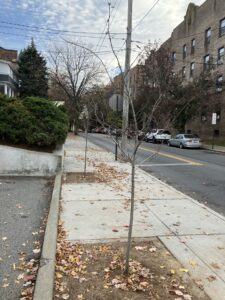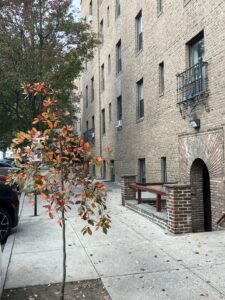
Beginning this month, the village of Sleepy Hollow will plant 100 native trees in public spaces throughout its neighborhoods. The project is supported by the Tree Power program of the New York Power Authority (NYPA). Because the village qualifies as a disadvantaged community, its annual tree budget was double-matched. For the combined total of $15,000, the village Tree Commission has selected eight species: swamp white oak, red oak, black gum, hop hornbeam, serviceberry, hackberry, scarlet oak, and Washington hawthorn.
The new trees will be planted in existing vacant tree pits, in turf beds between streets and sidewalks, and on lawns on village property. Village arborist Peter Strom advises that the best sites will “have plenty of room for roots to develop with no overhead utilities to limit the height and spread of the future canopy.” The pruning of trees away from power lines, as we often see in our neighborhoods, can impair the tree structure with consequences becoming apparent only decades later, so should be avoided.
According to Sleepy Hollow village code, trees “act as a natural noise barrier, provide oxygen, impede soil erosion and flooding, aid water absorption, absorb CO2 and other pollutants, provide shade, screening and privacy, and improve the character of the neighborhood.” A new controlled study in Louisville, KY demonstrates that urban trees in fact measurably improve health. There, 750 people of low and middle incomes living in a 4-mile area showed decreased levels of a blood marker associated with heart disease after trees and shrubs were planted in their neighborhoods. For more on the study, visit greenheartlouisville.com.
Urban areas that are most in need of trees tend also to have the most severe space restrictions, and Strom acknowledges that finding places where trees can thrive in the dense and heavily paved areas of the village will be a challenge. In some cases, pavement will be removed. Of the species chosen, redbud and serviceberry are best suited to tighter pits and will remain small enough not to interfere with overhead power lines. These species are also beautiful and useful: redbud produces a froth of magenta buds from bare branches in early spring, and serviceberry—which, like apple, pear, and plum is a member of the rose family—bears edible fruit. Some downtown streets in the village, such as Pocantico Street and Irving Place, have enough space and sunlight to host larger oaks. The tree commission invites residents to suggest sites for new trees by writing to 150treesforsh@gmail.com. Strom says, “these future shade trees will have a century to grow and benefit the community. Shade trees planted in our lifetime are our legacy for future generations.”
Trees and Climate Change

Irving Place. Photo: Peter Strom
Reducing the need for air conditioning and absorbing stormwater are significant environmental contributions. But NYPA’s main interest in tree planting would seem to relate to mitigating the effects of climate change by removing carbon dioxide from the atmosphere. The largest state public power utility in the US, NYPA maintains seven hydroelectric facilities, including one on the Niagara River, as well as a dozen gas-powered electric plants in New York City and Long Island. The Tree Power program, which planted trees in 30 communities in 2023, aims to contribute to Governor Hochul’s goal to plant 25 million trees by 2033.
Although there are differences between species and between rates of absorption in young and older trees, a tree on average absorbs 25 kg of CO2 per year. If Governor Hochul’s goal is met, the trees planted over the next decade will sequester an impressive 3,437,500 metric tons of carbon. Sadly, this is only about two percent of the carbon emitted by New York State in 2021 alone. Project Drawdown (drawdown.org/solutions/table-of-solutions) lists reduction of food waste and plant-rich diets as two of the most powerful measures to sequester warming gases, with onshore wind turbines and utility-scale photovoltaics at about half as effective, and tree plantation on degraded land half again as effective as that. Only all these actions—and the many more listed on their site—when taken together stand to have an impact.







